Effects of olive pulp addition to broiler diets on performance, selected biochemical parameters and antioxidant enzymes

Abstract
Olive oil production generates various by-products that can be used in animal nutrition. These by-products contain several polyphenolic compounds that may exhibit antioxidant properties. The present study was designed to evaluate the effects of adding olive pulp to the feed on broiler performance, carcass yield and antioxidant enzymes. Two hundred (200), as hatched, day-old, Cobb 500 broilers were reared in total for 42 days. There were 4 dietary treatments. In T1 treatment, no olive pulp was added to starter, grower and finisher diet. In T2 treatment, olive pulp was added to starter, grower and finisher diet at a level of 0, 2.5 and 5% respectively. In T3 treatment, olive pulp was added to starter, grower and finisher diet at a level of 0, 5 and 5% respectively. In T4 treatment, olive pulp was added to starter, grower and finisher diet at a level of 0, 5 and 8% respectively. Performance, carcass yield and a number of biochemical parameters were examined. Oleuropein and hydroxytyrosol were present in the olive pulp at 952 and 216 mg/kg respectively. Broilers performed well and no differences were observed between treatments on final body weight, carcass yield, total antioxidant activity and expression of selected antioxidant enzymes. Discriminant analysis was further applied and revealed that samples clustered according to added level of olive pulp. Samples from broilers fed T2 and T3 diet were located in the middle of the plot away from other treatments exhibiting high values of carcass, breast yield and most of the antioxidant enzyme activities. In conclusion, olive pulp can be used up to 5% in diets of broilers and future studies conducted on-farm conditions may pronounce its impact on growth performance and antioxidant potential.
Article Details
- How to Cite
-
PAPPAS, A., TSIPLAKOU, E., PAPADOMICHELAKIS, G., MITSIOPOULOU, C., SOTIRAKOGLOU, K., MPEKELIS, V., HAROUTOUNIAN, S., FEGEROS, K., & ZERVAS, G. (2019). Effects of olive pulp addition to broiler diets on performance, selected biochemical parameters and antioxidant enzymes. Journal of the Hellenic Veterinary Medical Society, 70(3), 1687–1696. https://doi.org/10.12681/jhvms.21793
- Issue
- Vol. 70 No. 3 (2019)
- Section
- Research Articles

This work is licensed under a Creative Commons Attribution-NonCommercial 4.0 International License.
Authors who publish with this journal agree to the following terms:
· Authors retain copyright and grant the journal right of first publication with the work simultaneously licensed under a Creative Commons Attribution Non-Commercial License that allows others to share the work with an acknowledgement of the work's authorship and initial publication in this journal.
· Authors are able to enter into separate, additional contractual arrangements for the non-exclusive distribution of the journal's published version of the work (e.g. post it to an institutional repository or publish it in a book), with an acknowledgement of its initial publication in this journal.
· Authors are permitted and encouraged to post their work online (preferably in institutional repositories or on their website) prior to and during the submission process, as it can lead to productive exchanges, as well as earlier and greater citation of published work.



